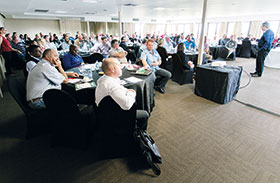

Earlier this year, Hi-Tech Security Solutions in association with Rob Anderson hosted a full house in Durban for our second Residential Estate Security Conference. This conference was the second in the residential security conferences Hi-Tech Security Solutions and Rob Anderson have hosted, aimed at the estates in and around the Durban area.
Due to the nature of the event and the impressive line-up of speakers and exhibitors, not only were there guests from KwaZulu-Natal, but the conference attracted people from the Western Cape, Gauteng and even estates in the Limpopo Province. Guests were able to spend the day listening to a range of presentations, as well as view the six exhibitors’ tables, where they were shown what solutions the various companies had for the residential estate market.
The sponsors and exhibitors for the conference were:
• Betafence.
• Comb Communications.
• Elvey Security Technologies.
• Enforce.
• MiRO.
• Powell Tronics.
It starts with a plan

The morning started with light breakfast snacks before Rob Anderson from Rob Anderson & Associates started the proceedings with a presentation titled Your Estate Security Plan. Anderson took delegates through some of the thought processes required when developing a security plan.
He stressed that, while getting outside help is important, the Homeowners Association (HoA) and the estate’s security leadership must understand what they are being sold, primarily by understanding what they need and want. In this respect, he suggests a security plan requires measuring one’s risk, devising ways to mitigate that risk, and then formulating a plan to put these measures into practice.
He also noted that a security plan must have intelligence. In other words, the ability to collect and collate data pertaining to the overall security of the environment with a view to analysing and continually improving your security processes based on real events. Anderson also noted that while manpower and electronics form the basis of every plan, data protection (or cyber security) is also critical to prevent sensitive information, such as residents’ identity details, from being stolen. You also want to prevent anyone from logging into your cameras and seeing what’s happening on your estate.
In a nutshell, Anderson recommends estates develop a plan that informs the relevant people about what is happening, provides intelligent and relevant reports in a timeous manner, and ensures that when an incident occurs the “where, what, when, why, how” questions are answered completely and quickly. Moreover, training is a critical part of any plan. If you have the best plan but don’t have the people able to carry it out, the plan is basically worthless.
Anderson then went on to mention some of the areas a plan must focus on, areas which were covered in the following presentations, as well as some reserved for a future discussion. One of the tools he recommended to assist in developing a security plan is the Estimate of Adversary Sequence Interruption (EASI) method of determining the route to criminals’ effectiveness.
Intelligence is the key

Following Anderson, Jan Botha, director of business development for Online Intelligence delivered a presentation specifically focused on intelligence. In Botha’s view, intelligence is not simply capturing a bunch of data, but capturing relevant data and turning that into actions which will prevent or avoid security breaches.
With the Ministry of Police’s report from September 2014 showing a 69.8% increase in robberies at residential properties over the previous nine years, estates are obviously facing a growing threat – although that will be no surprise to security managers. While people buy into estates in the hopes of a secure lifestyle, among other benefits, they are often misled and suffer from a false sense of security because, for example, they see a guard at the gate.
It’s better for everyone if one can detect and stop, or ideally prevent crime by applying your resources where it counts, rather than doing what you hope will work. This is where intelligence comes into play. When you know where your risks really are, you can deal with them. Unfortunately, this is an ongoing process as criminals have the time and money to adapt, forcing security teams to also adapt.
While there are many challenges for estate security teams to overcome, some from the residents themselves, security intelligence provides foreknowledge, highlights growing areas of risk, and supports estates in their tactical operations as well as the achievement of strategic objectives.
To obtain effective intelligence requires the integration of relevant internal and external information sources as well as the integration of various security disciplines. Botha suggests a unified dashboard with automated reporting and exception management is key to this, integrated with the technology and people deployed, and also being customised to each estate’s circumstances.
This unified dashboard will include, for example, alarm management, an electronic occurrence book, compliance, investigation management, and profiling and analysis capabilities. The result is a clear view of your risk profile, an understanding of where to focus your resources for maximum effect, and the availability of useful information to the personnel on the ground which empowers them to do their jobs more effectively.
More than a fence

Dan Edwards from Betafence was up next with a presentation on perimeter security. Edwards discussed the progression of the fence over the years to the options users have today – which is more than simply a few bits of intertwined wire on the perimeter. He sees the role of the fence in an effective security system in the same manner he views the rhythm section of a jazz band, it sets the framework for the rest of the band to play the melody. From this perspective, the fence is an integral part of the security design, playing an important and integrated role among newer technologies and solutions.
Moreover, the fence is what most people see of an estate and it therefore needs to be aesthetically pleasing to the eye, while supporting the security strategy of the estate. Apart from aesthetics, Edwards highlighted three trends in fencing designs today:
• A focus on mesh fences that are hard to cut and climb.
• A move to innovative coatings such as PVC instead of paint or powder coating.
• A move towards flat panel systems.
Edwards went on to discuss the various ways in which fences are designed to keep people out by preventing them from going over, under or through the fence, as well as the cost differences customers will experience if they install a fence properly on sloping ground. For example, the difference in cost between a level fence and one of the same style installed on ground that slopes over 250 mm would be about a 79% increase. Information that many estates only understand after making a decision.
A video was also shown in which a crack team of SAPS professionals were tasked with breaking through a variety of security fences. They were timed to determine which fence gave them the hardest challenge. As Edwards noted before the video, no fence is impenetrable, it’s only a matter of how much trouble it gives the criminals, meaning how long it delays their ingress. The video showed that some fences, which look secure, could be breached in about 10 seconds, while better solutions took over 10 minutes.
This doesn’t mean every installation requires the most expensive perimeter solution, but the solution chosen must be fit for purpose. In other words, in some cases one requires the best, in others something else will suffice – assuming you can make that decision because you have identified your risks and the mitigation required in your security plan.
Access that works

Once your perimeter is sorted, the next step is to decide how, when and where you will allow people, residents and visitors, to enter and exit the estate, and under what conditions. Frazer Matchett from Powell Tronics offered some insights in his presentation, titled Getting Results from Access Control and Visitor Management.
Matchett said the core element of access control are:
• Identification: For access control to be effective, there needs to be a way to identify individuals, i.e. who are you? The weakest form of identification will simply identify an individual that belongs to a rather vague category, such as a contractor, company or the colour of their shirt etc. Correct identification needs some sort of pre-recognition.
• Authentication: We can’t simply rely on an individual to tell us his/her identity, there needs to be a way to prove it. In an estate setting, these can be fingerprints, identity documents or smart cards, driver’s licence etc.
• Authorisation: Once identified and authenticated, a person is then granted authorisations to enter an estate once or multiple times, access certain areas and so forth. In most cases, authorisation means they are allowed to enter, but places no further restrictions on them. Each estate needs to decide if this is acceptable and create an environment where access is restricted, if required.
To build an effective access control system, each estate needs to consider how it can make access and egress easy and fast for residents, as well as authorised visitors. He said an estate also needs to ensure it is able to record the correct details of visitors and residents, and keep them secure. There should also be a carefully designed and practiced disaster recovery plan: there is no worse solution to a disaster than going back to the ‘honesty book’ or simply opening the gates to anyone.
Cameras in view
With your first perimeter defence (the fence) as well as your access control policies under control, it’s time to look at additional security technology that will act as an additional perimeter and access layer of security, as well as provide support for guards and control room operators as they enforce the estate’s security plan.

Video surveillance is often the solution in this regard and Philip Smerkovitz from TeleEye SA spoke about surveillance cameras, introducing the audience to the workings and benefits of both thermal and optical cameras.
Smerkovitz first took delegates through a short overview of optical cameras, showing how they worked and how they have improved over the years, as well as a quick introduction to how light works. While this may seem to be beyond the scope of estate security, it is a vital component in selecting the right camera for the job you want it to do.
Lenses and sensors, as well as light sources were also discussed before Smerkovitz went into the evolution of image sizes, from analogue to today’s ultra high definition cameras. He then focused on detection, recognition and identification with the relevant insights into what was required for which purposes – such as capturing a number plate or simply to detect movement on the perimeter.
Then it was the turn of thermal cameras. Smerkovitz again described how these cameras work, why and where they are a good choice in conjunction with optical cameras or on their own. He went further into the benefits and advances in thermal technology, and where these could make a difference in estates.
He ended the presentation with a look at what features buyers should look for in order to achieve specific results, as well as the total cost of operating optical and thermal cameras in, for example, perimeter security. Smerkovitz also brought along a multi-million rand Flir thermal camera and set it up to give attendees an overview of the capabilities and benefits of these devices.
All about analytics

You can’t talk about video surveillance without also looking at the value video analytics adds to almost any surveillance operation. Bosch Security Systems’ Jason McGregor followed with a presentation highlighting the trends in video surveillance as well as the role analytics plays in the surveillance world, with a focus on residential estates.
As far as trends are concerned, McGregor highlighted five primary trends in the surveillance world at the moment:
• 180/360-degree cameras.
• 4 K technology.
• Convergence.
• IoT (Internet of Things) and mobile access.
• Data security.
He then went on to discuss video analytics, starting out by differentiating between motion detection (used to determine the presence of motion in an observed scene) and true analytics (analysing video to detect and determine temporal events not based on a single scene).
He also explained the differences and benefits of server-based and edge-based analytics. Server-based analytics happens on the server in a central location and provides increased computing power to analyse video streams as well as the ability to compile information gained in a database for future reference and analysis. Edge-based analytics happens on the camera using the uncompressed images and works autonomously from the central server and control room.
McGregor then went on to explain how to get the most out of analytics by selecting the right camera. The ‘right camera’ in this context is a system made up of the right components. Effective analytics relies on the size of the camera sensor, the lens, resolution and so forth. It also relies on correctly setting up the camera, which includes placing it at the appropriate height and at the right angle to the ground etc.
The scene being observed also plays a role in analytics and the camera setup. Security decision makers therefore must take all these issues into consideration if they are to gain the best results from their analytics.
Effective guarding
Despite the many advances in technology, the use of human security personnel is still a critical aspect of securing estates. Guards, unfortunately, have a bad reputation and we often hear of those who neglect their duties and rarely hear of those who go the extra mile.

Ettiene de Lange, security manager for the Ebotse Home Owners Association gave the delegates some insight into the processes his estate goes though in ensuring their guards are trained, motivated and focused to achieve the most efficient service.
De Lange believes that a successful guarding function in an estate requires knowledge, hard work, and most of all, a positive attitude.
Knowledge means understanding “where to post what grade of security officer and why”. He then expanded on security officer grades (according to PSIRA’s classification), and looked at what these officers are then trained to handle. De Lange also noted that assessing your guards onsite is important as one often finds a more skilled and capable individual that is of a lower grade.
The next step is where hard work and training come into the picture, as many estates will have a different set of criteria expected from guards, beyond the basic training they receive from the guarding companies, and they will need to be trained to deliver on expectations. For those few estates that employ their guards directly, training is even more important, ensuring their people are qualified, registered and motivated to deliver the service required.
Regular performance evaluations are also a necessity. They will quickly highlight any areas of training that are required and keep your security staff on their toes, especially when their performance is taken into account for future promotions, pay increases or bonuses.
Regular training is also important to keep the estate secured. When criminals are thwarted, they simply change their approach, which means your security team must also adapt and change to deal with the new threats. The only way to ensure your guards are capable is via training and evaluation.
De Lange went on to talk on motivation strategies, as well as how to deal with the abuse some residents seem to enjoy heaping on guards while they are simply doing their jobs. He also touched on the documentation processes required, which should be mandatory to ensure your guarding function is documented from start to finish. This not only keeps track of what is happening and what should be happening, it also feeds into the overall intelligence gathering process of the estate in order to optimise efficiencies.
Manpower and technology integration

Staying on the topic of people and the broader guarding process, Glenn Allen from Enforce Security Services followed with a presentation looking at how and why the guarding function should be supplemented, even boosted with the addition of the right technologies.
Allen noted that, just as estates required guarding personnel, they also need technology to assist people in doing their jobs better. However, simply buying technology is not a solution either as each estate will need to make the effort to integrate its security manpower and technology in order to achieve an efficient security solution.
This integration relates back to the original security plan, making sure the process improves the overall goal of the HoA by integrating or converging the various elements at play in a guarding solution. It’s not a simple process either, as Allen noted there are generally four role players that need to be considered in this convergence.
The players are the security manager and/or estate manager, the security guards, the technicians who install the equipment, and IT specialists who are playing a larger role in estate security systems than ever before. The challenge is to integrate each of these role players, who often have vastly different priorities and can sometimes be accused of speaking a different language, into the overall security function.
Effective integration requires a mindset change from all parties and an understanding of each other’s areas of expertise and areas of weakness. Cross training is one way of accomplishing this as it assists people in understanding where others are coming from as well as the challenges they deal with. It’s also important to develop a common “language” to avoid frustrations caused by miscommunication.
The control room

Ian Downie from Xone was up next. He continued to speak about security personnel and using technology to assist them, but from the perspective of the control room. Often neglected, the control room plays a critical role in an effective security operation.
Downie started by asking the delegates, “do you want to die?”, before asking whether saving 10% or 20% on their security budget was worth the risk to families?
He then went on to examine the value a quality control room with good staff will add to a security operation in an estate. Downie’s basic roadmap to improved security involves good people, good technology and good processes, which together increases an estate’s ability to stop threats.
He noted that while many, if not most estates are beginning to use technology effectively, most still do not have appropriate control rooms to support their people and technology. Downie said control rooms are often an afterthought. They are not correctly designed and mostly manned by ‘normal’ security personnel as estates try to cut the cost of security officers to a minimum, rather than paying a competent company more to deliver a better service with less people. Moreover, processes are poorly documented and managed.
To ensure estates have effective control rooms, they need an effective command and control environment. This requires quality and trained staff in the control room who are appropriately paid (you need less people, but get a higher calibre of operator). They need to be supported by proper management tools that enable logging and reporting of everything. It’s critical to design and develop a service-level agreement (SLA) driven security culture.
Downie also discussed the pros and cons of onsite or offsite control rooms, noting that simply because a control room is offsite does not mean it will be cheaper or better than an onsite operation – buying cheap always gets the same result. Estates need to consider what they require from their control rooms before making the on- or offsite decision.
He also went into the importance of defined processes and outcomes, a drive for continual improvement, regular auditing of the control room function as well as the use of innovative technologies. The appropriate control room technology will result in better security and improved data collection, which means better intelligence which can be fed back into the security operation.
Sample plan
Ending the presentations for the day, Rob Anderson returned and wrapped up by integrating all the information delivered during the day by giving the attendees insight into designing their own security plan. While there obviously was not enough time to design full plan to secure an estate, Anderson highlighted the method to develop a plan, as well as the areas which estates should focus on if they want an holistic security operation.
Hi-Tech Security Solutions wishes to thank the attendees who joined us on the day, some of whom travelled hundreds of kilometres to be there. Out thanks also goes out to the sponsors (Betafence, Comb Communications, Elvey Security Technologies, Enforce, MiRO, and Powell Tronics) who made the day possible.
The audience feedback showed that the presentations hit the spot when it comes to the challenges estates are facing today, and we therefore owe a debt of gratitude to our speakers, many of which flew in specifically for the conference. Their time and effort is much appreciated.
| Tel: | +27 11 543 5800 |
| Email: | malckey@technews.co.za |
| www: | www.technews.co.za |
| Articles: | More information and articles about Technews Publishing |

© Technews Publishing (Pty) Ltd. | All Rights Reserved.